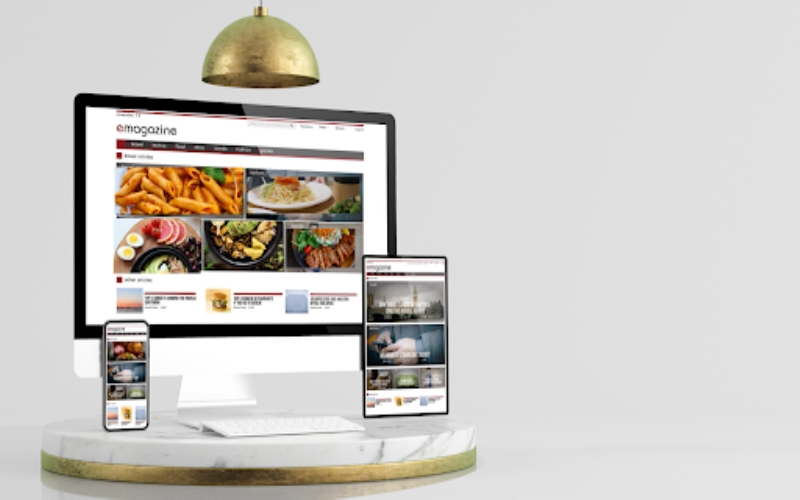In the rapidly evolving digital landscape, where mobile devices have seamlessly integrated into our daily lives, the significance of a mobile-friendly design cannot be emphasized enough, particularly in the context of restaurant websites. In this article, we will delve into the multifaceted reasons that underscore the critical importance of ensuring that restaurant site templates are optimized for mobile devices.
1. Introduction
In today’s dining landscape, a strong online presence is essential for restaurants, given the prevalence of smartphones. A mobile-friendly design goes beyond looks; it’s about providing a seamless experience for the growing number of users accessing websites on their mobile devices. This adaptability is crucial for enhancing user satisfaction and staying competitive in a market where convenience and tech-savviness matter.
A well-optimized mobile site not only attracts customers but also reflects a restaurant’s commitment to modernity. It serves as a virtual gateway, influencing potential patrons and contributing to the overall success of the establishment in a digitally-driven world.
2. Impact on User Experience
One of the primary reasons for prioritizing mobile-friendly design is its positive impact on user experience. Responsive design ensures that the website adapts seamlessly to different screen sizes, providing users with a consistent and enjoyable browsing experience. Additionally, faster loading times on mobile devices contribute to a user-friendly environment, preventing potential customers from bouncing off the site due to sluggish performance.
3. Google’s Mobile-First Indexing
In the dynamic landscape of search engine algorithms, acknowledging Google’s inclination towards mobile-friendly websites is imperative. The advent of mobile-first indexing underscores a pivotal shift in how Google assesses and ranks web content. Essentially, this approach prioritizes the mobile version of a website’s content for indexing and subsequent ranking.
This paradigm places a premium on websites that are adeptly optimized for mobile devices, signaling a profound impact on their search engine visibility. As Google increasingly prioritizes the mobile experience, websites that seamlessly cater to mobile users are not only more favorably indexed but also stand a greater chance of securing higher ranks in search engine results. This shift underscores the critical importance of mobile optimization in influencing online visibility and ensuring sustained prominence in the ever-evolving digital realm.
4. Increasing Mobile Traffic
The statistics speak for themselves – mobile internet usage is on the rise. Ignoring the mobile audience means missing out on a substantial chunk of potential customers. Restaurants that invest in mobile-friendly designs not only cater to the current user trends but also position themselves for future growth as mobile usage continues to climb.
5. Customer Accessibility
For the modern diner, convenience is key. A mobile-friendly best restaurant website ensures that customers can easily find the information they need, from menu details to operating hours, right at their fingertips. Accessibility is not just a feature; it’s a cornerstone of customer satisfaction.
6. Visual Appeal on Mobile Devices
A visually appealing website is an asset, and on mobile devices, it becomes even more critical. With smaller screens, every detail counts. A well-designed mobile site enhances the overall visual experience, enticing users to explore further and potentially make a reservation or place an order.
7. Local SEO and Mobile Friendliness
Local search optimization is paramount for restaurants looking to attract nearby customers. Mobile-friendly design plays a pivotal role in local SEO, ensuring that the restaurant appears in relevant searches when users are looking for dining options in a specific area.
8. Competitive Advantage
In a competitive industry like the restaurant business, setting oneself apart is essential. A mobile-friendly website not only meets customer expectations but also gives a restaurant a competitive edge. It reflects a commitment to staying current and meeting the evolving needs of tech-savvy diners.
9. Social Media Integration
The relationship between mobile-friendly design and social media cannot be overstated. A seamless integration allows users to share their dining experiences easily, contributing to word-of-mouth marketing. Social media becomes a powerful ally in promoting the restaurant’s brand and attracting a broader audience.
10. Adaptability to Various Devices
With the plethora of devices available, from smartphones to tablets, ensuring that the restaurant website is accessible on different screens is crucial. A mobile-friendly design is adaptable, providing a consistent experience regardless of the device used, expanding the reach to a diverse audience.
11. Mobile-Friendly Features for Restaurants
Beyond responsive design, incorporating specific mobile-friendly features enhances the user experience. Online menus with clear images, easy navigation, and the ability to place orders online contribute to customer satisfaction. Integration with reservation systems simplifies the process for both customers and restaurant staff.
12. Case Studies of Successful Implementations
To underscore the importance of mobile-friendly design, let’s delve into a few case studies. Restaurants that embraced mobile optimization experienced increased website traffic, higher conversion rates, and positive customer feedback. These success stories highlight the tangible benefits of prioritizing mobile-friendly design.
13. Challenges in Implementing Mobile-Friendly Design
Transitioning to a mobile-friendly design may pose challenges for some restaurants. Common issues include technical hurdles, budget constraints, and resistance to change. However, overcoming these challenges is vital to staying competitive and meeting the expectations of today’s digital-savvy consumers.
14. Future Trends in Mobile Design for Restaurants
As technology continues to advance, the future holds exciting possibilities for mobile design in the restaurant industry. Augmented reality menus, personalized dining experiences through mobile apps, and integration with emerging technologies are on the horizon. Restaurants that stay abreast of these trends position themselves for sustained success.
15. Conclusion
In summary, emphasizing the importance of prioritizing mobile-friendly design in restaurant website templates is paramount. This strategy goes beyond merely enhancing user experience and improving Google rankings; it is essential for attracting a broader audience and staying competitive in the rapidly evolving digital landscape.
The advantages are multifaceted, underscoring that adopting a mobile-first approach is not just a passing trend but a fundamental necessity for restaurants aiming to achieve enduring growth in the digital age. This shift towards mobile responsiveness ensures that establishments are not only keeping pace with current expectations but also future-proofing their online presence for sustained success.


